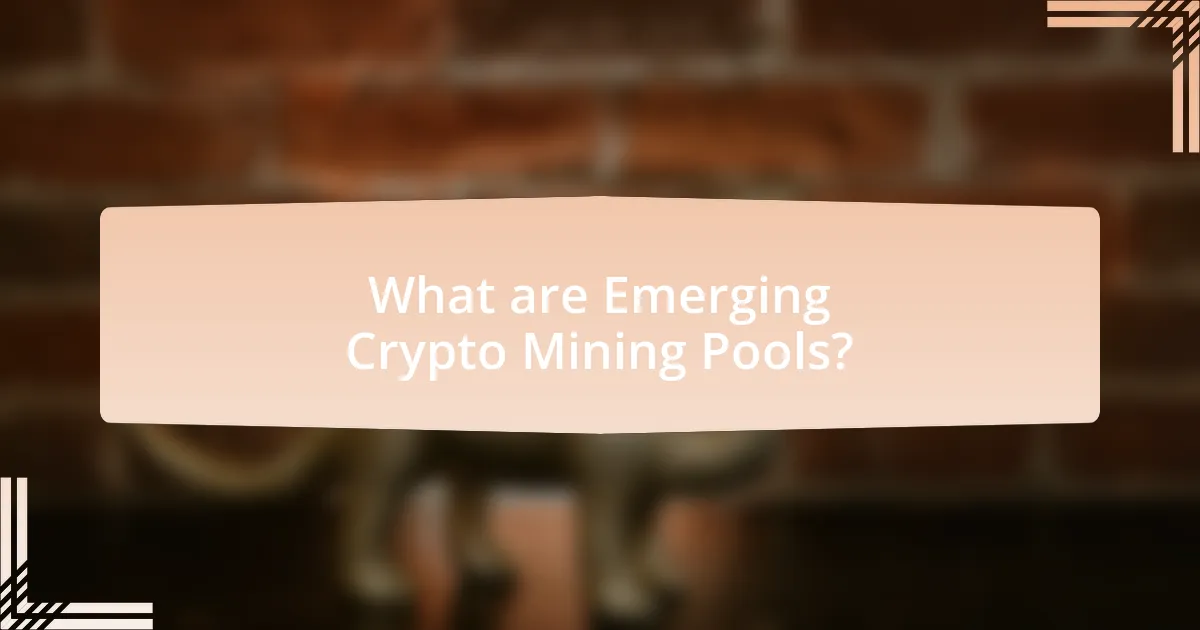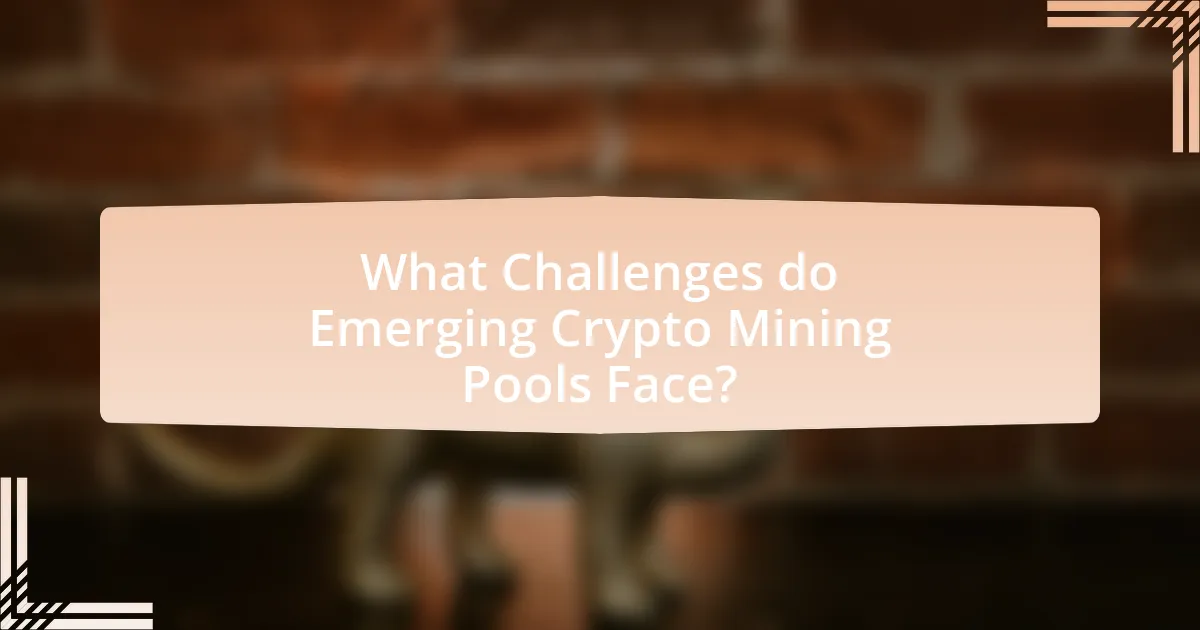Emerging crypto mining pools represent collaborative networks where individual miners combine their computational resources to enhance the efficiency and profitability of cryptocurrency mining. This article analyzes the operational differences between emerging and traditional mining pools, highlighting advancements in technology that facilitate their growth. It discusses the increasing demand for decentralized mining solutions, the impact of regulatory changes, and the challenges faced by these pools, including competition and security risks. Additionally, the article explores the financial advantages for miners, the role of these pools in the broader cryptocurrency ecosystem, and strategies for navigating the evolving landscape of crypto mining.

What are Emerging Crypto Mining Pools?
Emerging crypto mining pools are collaborative networks where individual miners combine their computational resources to increase the chances of successfully mining cryptocurrency. These pools allow participants to share the rewards based on their contributed processing power, making mining more accessible and efficient, especially for smaller miners who may struggle to compete against larger operations. The rise of these pools is driven by the increasing complexity of mining algorithms and the need for collective effort to achieve profitability in a competitive market. According to a report by CoinShares, as of 2021, mining pools accounted for over 70% of the total Bitcoin hash rate, highlighting their significance in the cryptocurrency ecosystem.
How do Emerging Crypto Mining Pools differ from traditional mining pools?
Emerging crypto mining pools differ from traditional mining pools primarily in their operational models and technological integration. Traditional mining pools typically rely on centralized management and fixed reward structures, while emerging pools often utilize decentralized governance and dynamic reward mechanisms that adapt to market conditions. For instance, emerging pools may implement innovative algorithms that optimize resource allocation and enhance profitability, reflecting the evolving landscape of blockchain technology. This shift is supported by the increasing adoption of decentralized finance (DeFi) principles, which promote transparency and efficiency in mining operations.
What technological advancements contribute to the emergence of new mining pools?
Technological advancements such as improved mining hardware, enhanced software algorithms, and the integration of cloud computing contribute significantly to the emergence of new mining pools. Advanced mining hardware, like ASIC miners, increases efficiency and processing power, allowing pools to solve blocks more quickly. Enhanced software algorithms optimize the distribution of work among miners, improving overall performance and reducing latency. Additionally, cloud computing enables miners to join pools without the need for significant upfront investment in hardware, making mining more accessible. These advancements collectively lower barriers to entry and foster the growth of new mining pools in the cryptocurrency ecosystem.
How do these differences impact miners and investors?
Differences in mining pool structures and reward mechanisms significantly impact miners and investors by influencing profitability and investment decisions. For miners, variations in payout methods, such as Pay-Per-Share (PPS) versus Pay-Per-Last-N-Shares (PPLNS), determine their earnings stability and risk exposure; for instance, PPS offers consistent payouts, which can attract miners seeking lower risk. Investors, on the other hand, are affected by these differences as they assess the potential returns on investment; pools with higher efficiency and lower fees tend to attract more capital, leading to increased market competitiveness. According to a study by the Cambridge Centre for Alternative Finance, mining pools that optimize their operational efficiency can yield up to 30% higher returns for investors compared to less efficient pools.
Why is the market for Emerging Crypto Mining Pools growing?
The market for Emerging Crypto Mining Pools is growing due to the increasing demand for decentralized cryptocurrency mining solutions. As more individuals and small-scale miners seek to participate in the crypto ecosystem, they are turning to mining pools to combine resources and enhance profitability. According to a report by Statista, the global cryptocurrency mining market is projected to reach $1.6 billion by 2025, indicating a significant growth trajectory. This trend is further fueled by advancements in mining technology and the rising value of cryptocurrencies, which incentivize participation in mining pools for shared rewards and reduced operational costs.
What factors are driving the demand for these mining pools?
The demand for mining pools is primarily driven by the need for increased efficiency and profitability in cryptocurrency mining. As individual miners face challenges such as high operational costs and increased competition, joining mining pools allows them to combine resources, share expenses, and enhance their chances of earning rewards. Additionally, the growing complexity of mining algorithms and the need for substantial computational power make it difficult for solo miners to compete effectively. According to a report by Cambridge Centre for Alternative Finance, mining pools accounted for over 70% of Bitcoin’s total hash rate in 2021, highlighting their critical role in the mining ecosystem.
How do regulatory changes influence the growth of mining pools?
Regulatory changes significantly influence the growth of mining pools by altering the operational landscape and compliance requirements. For instance, stricter regulations can lead to increased operational costs for mining pools, as they may need to invest in compliance measures or relocate to jurisdictions with more favorable regulations. Conversely, favorable regulatory environments can encourage the establishment and expansion of mining pools by providing legal clarity and reducing barriers to entry. A notable example is China’s crackdown on cryptocurrency mining in 2021, which resulted in a mass exodus of miners to countries with more lenient regulations, thereby reshaping the global distribution of mining pools. This shift illustrates how regulatory frameworks directly impact the viability and growth potential of mining pools in the cryptocurrency ecosystem.

What Opportunities do Emerging Crypto Mining Pools Present?
Emerging crypto mining pools present opportunities for increased efficiency and profitability in cryptocurrency mining. These pools allow individual miners to combine their computational power, which enhances the chances of successfully mining blocks and receiving rewards. For instance, according to a report by Cambridge Centre for Alternative Finance, mining pools accounted for over 70% of Bitcoin’s total hash rate in 2021, demonstrating their significant role in the mining ecosystem. Additionally, emerging pools often offer lower fees and innovative reward structures, attracting more miners and fostering competition, which can lead to better overall returns.
How can miners benefit from joining Emerging Crypto Mining Pools?
Miners can benefit from joining emerging crypto mining pools by gaining access to increased computational power and more consistent rewards. By pooling resources, miners can collectively solve blocks more efficiently, which enhances their chances of earning cryptocurrency rewards compared to solo mining. For instance, according to a study by Cambridge Centre for Alternative Finance, mining pools account for over 70% of the total Bitcoin network hash rate, demonstrating their significant role in improving mining efficiency and profitability. Additionally, emerging pools often offer lower fees and innovative reward structures, further incentivizing participation and maximizing miners’ returns.
What are the potential financial advantages for miners?
Miners can experience significant financial advantages through rewards from block validation and transaction fees. When miners successfully validate a block in a blockchain network, they receive a predetermined reward, which can be substantial, especially in the early stages of a cryptocurrency’s lifecycle. For instance, Bitcoin miners earned 6.25 BTC per block as of 2020, translating to over $200,000 at current market prices. Additionally, miners collect transaction fees from users who prioritize their transactions, further enhancing their income. This dual revenue stream—block rewards and transaction fees—provides miners with a robust financial incentive to maintain and secure the network.
How do these pools enhance mining efficiency and profitability?
Mining pools enhance mining efficiency and profitability by allowing multiple miners to combine their computational power, increasing the likelihood of successfully solving blocks and receiving rewards. This collective effort reduces the variance in earnings, as miners receive consistent payouts based on their contributed hash rate, rather than relying solely on individual mining success. For instance, according to a study by the Cambridge Centre for Alternative Finance, mining pools account for over 70% of the total Bitcoin network hash rate, demonstrating their significant role in stabilizing income for miners. Additionally, pools often provide advanced tools and analytics, enabling miners to optimize their operations and make informed decisions, further enhancing profitability.
What role do Emerging Crypto Mining Pools play in the broader cryptocurrency ecosystem?
Emerging crypto mining pools play a crucial role in the broader cryptocurrency ecosystem by enhancing the efficiency and profitability of mining operations. These pools allow individual miners to combine their computational power, increasing the likelihood of successfully mining blocks and receiving rewards. For instance, according to a report by Cambridge Centre for Alternative Finance, mining pools accounted for over 60% of Bitcoin’s total hash rate in 2021, demonstrating their significant influence on network security and stability. By pooling resources, miners can mitigate the risks associated with solo mining, such as high variance in income and the need for substantial investment in hardware. This collaborative approach not only democratizes access to mining rewards but also contributes to the overall decentralization and resilience of the cryptocurrency network.
How do they contribute to network security and decentralization?
Crypto mining pools contribute to network security and decentralization by aggregating computational power from multiple miners, which enhances the overall security of the blockchain network. This collective effort makes it more difficult for any single entity to execute a 51% attack, as the combined hash rate of the pool increases the network’s resistance to such threats. Additionally, mining pools promote decentralization by allowing smaller miners to participate in the mining process, ensuring that no single miner or group can dominate the network. This distribution of power across various participants helps maintain the integrity and resilience of the blockchain ecosystem.
What partnerships or collaborations are forming around these pools?
Partnerships and collaborations are forming around emerging crypto mining pools primarily between technology providers and mining hardware manufacturers. For instance, companies like Bitmain are collaborating with various mining pools to optimize hardware performance and enhance mining efficiency. Additionally, some pools are partnering with blockchain platforms to offer integrated services, such as payment solutions and staking options, which can attract more miners. These collaborations are aimed at improving operational capabilities and expanding market reach, as evidenced by the increasing number of joint ventures announced in industry reports.

What Challenges do Emerging Crypto Mining Pools Face?
Emerging crypto mining pools face several significant challenges, including regulatory uncertainty, competition from established pools, and technological barriers. Regulatory uncertainty arises as governments worldwide grapple with how to classify and regulate cryptocurrencies, which can impact the operational viability of mining pools. Competition is fierce, as established mining pools dominate the market, making it difficult for new entrants to attract miners and secure a share of the rewards. Additionally, technological barriers, such as the need for advanced hardware and efficient energy consumption, pose challenges for emerging pools to remain profitable and competitive. These factors collectively hinder the growth and sustainability of new mining pools in the evolving cryptocurrency landscape.
What are the main risks associated with Emerging Crypto Mining Pools?
The main risks associated with emerging crypto mining pools include centralization, security vulnerabilities, and regulatory challenges. Centralization occurs when a few mining pools dominate the market, leading to potential manipulation of the network and reduced decentralization benefits. Security vulnerabilities arise from the pooling of resources, making them attractive targets for cyberattacks, which can result in significant financial losses. Regulatory challenges stem from the evolving legal landscape surrounding cryptocurrencies, where emerging pools may face compliance issues that could jeopardize their operations. These risks highlight the complexities and uncertainties inherent in the rapidly changing crypto mining environment.
How do market volatility and price fluctuations affect these pools?
Market volatility and price fluctuations significantly impact crypto mining pools by influencing their profitability and operational sustainability. When cryptocurrency prices rise, mining pools often experience increased revenue due to higher rewards for mined blocks, attracting more miners and increasing competition. Conversely, during periods of price decline, mining pools may face reduced profitability, leading to potential exits of less efficient miners and a decrease in overall network hash rate. Historical data shows that in 2018, Bitcoin’s price drop led to a 50% reduction in mining profitability, causing many miners to shut down operations. This dynamic illustrates how market conditions directly affect the viability and attractiveness of mining pools.
What security concerns should miners be aware of?
Miners should be aware of several security concerns, including the risk of hacking, hardware theft, and software vulnerabilities. Hacking incidents can lead to the loss of mined cryptocurrencies, as seen in high-profile breaches where attackers exploited weaknesses in mining pool security protocols. Hardware theft is another significant concern, as mining equipment can be valuable and targeted by criminals. Additionally, software vulnerabilities can expose miners to malware attacks, which can compromise their operations and lead to financial losses. According to a report by Cybersecurity Ventures, cybercrime is projected to cost the world $10.5 trillion annually by 2025, highlighting the importance of robust security measures for miners.
How do regulatory challenges impact Emerging Crypto Mining Pools?
Regulatory challenges significantly impact emerging crypto mining pools by creating operational uncertainties and compliance costs. These challenges can lead to restrictions on mining activities, as seen in countries like China, where crackdowns on crypto mining resulted in the closure of numerous operations, forcing miners to relocate or shut down. Additionally, regulatory frameworks often require mining pools to adhere to specific licensing and reporting requirements, increasing operational expenses and complicating business models. For instance, in the United States, the Financial Crimes Enforcement Network (FinCEN) has imposed regulations that require crypto businesses to register as money services businesses, which adds compliance burdens. Such regulatory environments can deter investment and innovation in the sector, ultimately affecting the growth and sustainability of emerging crypto mining pools.
What are the implications of changing regulations on mining operations?
Changing regulations on mining operations can significantly impact operational costs, compliance requirements, and market dynamics. For instance, stricter environmental regulations may increase costs for mining companies due to the need for advanced technologies to reduce emissions and waste. Additionally, regulatory changes can affect the availability of permits, influencing the speed and feasibility of new mining projects. Historical data shows that in 2021, China’s crackdown on cryptocurrency mining led to a 50% reduction in global Bitcoin hash rate, demonstrating how regulatory shifts can disrupt market stability and operational viability.
How can mining pools adapt to comply with new laws?
Mining pools can adapt to comply with new laws by implementing robust compliance frameworks that include regular audits, transparent reporting, and adherence to local regulations. These frameworks ensure that mining pools meet legal requirements related to taxation, anti-money laundering (AML), and know your customer (KYC) protocols. For instance, in jurisdictions like the European Union, mining pools must comply with the Fifth Anti-Money Laundering Directive, which mandates the identification of users and reporting of suspicious activities. By integrating compliance technologies and collaborating with legal experts, mining pools can effectively navigate the evolving regulatory landscape and mitigate risks associated with non-compliance.
What strategies can miners employ to navigate the challenges of Emerging Crypto Mining Pools?
Miners can employ diversification, strategic partnerships, and technological upgrades to navigate the challenges of emerging crypto mining pools. Diversification allows miners to spread their resources across multiple pools, reducing dependency on any single entity and mitigating risks associated with pool performance fluctuations. Strategic partnerships with established pools can provide miners access to better resources, shared knowledge, and enhanced bargaining power. Additionally, investing in technological upgrades, such as more efficient mining hardware and software, can improve miners’ competitiveness and profitability in a rapidly evolving market. These strategies are supported by the fact that miners who adapt to changing conditions and leverage collaborative opportunities tend to achieve better outcomes in the dynamic landscape of crypto mining.
What best practices should miners follow to maximize their success?
Miners should prioritize efficient hardware selection, optimal energy consumption, and strategic pool participation to maximize their success. Efficient hardware, such as ASIC miners, enhances hashing power, leading to higher chances of earning rewards. Additionally, minimizing energy costs through renewable sources or low-cost electricity can significantly improve profitability, as energy expenses often constitute the largest operational cost in mining. Furthermore, choosing the right mining pool, which offers favorable fees and reliable payouts, can increase overall returns. Research indicates that miners who adopt these practices can improve their profitability by up to 30%, demonstrating the importance of strategic decision-making in the competitive landscape of crypto mining.
How can miners stay informed about market trends and regulatory changes?
Miners can stay informed about market trends and regulatory changes by utilizing a combination of industry news platforms, social media channels, and regulatory websites. Industry news platforms such as CoinDesk and CoinTelegraph provide timely updates on market fluctuations and regulatory developments, while social media channels like Twitter and Reddit allow miners to engage with real-time discussions and insights from experts and peers. Regulatory websites, including those of government agencies and financial authorities, offer official information on compliance requirements and legal changes affecting the mining sector. This multi-faceted approach ensures that miners have access to comprehensive and up-to-date information, enabling them to make informed decisions in a rapidly evolving landscape.